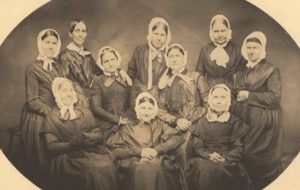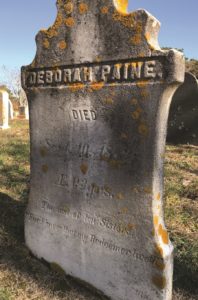“A most remarkable picture was taken yesterday” read an item in the Sept. 30, 1851 issue of the Boston Evening Transcript.
The story announced that the artists Ormsbee and Silsbee had “fitted up” rooms at 203 Washington St. as a daguerreotype studio. The subjects these talented artists had captured, said the report, were the family of the late Thomas Gross of Wellfleet, Cape Cod, “consisting of ten sisters, whose united ages number 702 years; the eldest being 85 and the youngest 57.” It would be the only time that the sisters were all together.

The famous Gross sisters, as they came to be known, were among the 14 children — 10 daughters and four sons — born to Deacon Thomas Gross (1740-1817) and his wife, Abigail Young (1750-1835) who lived near Gull Pond.
All the siblings, except for a brother who died young and another who drowned at age 50, enjoyed remarkable longevity.
A deacon in the Congregational Church, Thomas joined Abigail in 1802 in the Methodist Church when she, their oldest child, Lurania Higgins, and Thankful Rich became the first class of Methodists in Wellfleet.
Historian Shebnah Rich notes in his Truro — Cape Cod that Methodist preaching had become an alternative to Congregationalism here by the mid-1790s. Truro’s Methodist meetinghouse, a simple frame structure with backless benches, was built at South Truro (near the Pine Grove Cemetery) soon thereafter to accommodate the growing congregation that had been gathering in private homes from Provincetown to Wellfleet. It was the first Methodist meetinghouse built on Cape Cod and the second in New England.
By 1827, a new Methodist Episcopal church stood at Truro Center, adjacent to a burial ground that is now the Methodist Cemetery, where Deacon Thomas, Abigail, and their daughter Deborah are buried. Wellfleet members had already withdrawn from Truro and built their own modest meetinghouse in 1817 at the present-day Pleasant Hill Cemetery atop Gross Hill Road. When burials began in 1819, lots were granted only to Methodists. That same year, the first Methodist camp meeting, an outdoor revival, was held at South Wellfleet with later meetings held on Bound Brook Island.
The Gross sisters were all members of the Methodist Church and, with its rich musical tradition fostered by camp meetings, all were singers of ability.
All married and all but one, Sally, had children. Two sisters, Thankful and Mary, married Methodist preachers; Cynthia was said to be the Cape’s most famous midwife; Bethiah was born the day after the Battle of Bunker Hill (the Wellfleet oysterman, John Young Newcomb, told Thoreau that he had heard the cannons); and Lurania, the mother of 10 children and wife of Eleazer Higgins (who had been taken prisoner in 1780, sent to England, and confined in Mill Prison for 18 months), received a Revolutionary War widow’s pension. Rebecca went to Boston, Abigail to Scituate. Miriam, the wife of Freeman Atkins of Provincetown, lived in what is today the Red Inn. Deborah, born in 1789, was the last surviving sister.

If the daguerreotype of the pious Gross sisters enchanted the public, so too did an intriguing, indeed fantastical, family story that began circulating widely: that the Young and Gross families were related to Hawaiian royalty.
The story begins with David Young, uncle to the sisters and younger brother of Abigail. Born in 1759 to Jonathan Young and Rebecca Harding, David was believed to have changed his name to John in 1789 before sailing as a boatswain aboard the Eleanor from Newburyport on a fur trading voyage to the Pacific Ocean.
Detained in the Sandwich Islands, John would have met his demise had it not been for the intercession of King Kamehameha’s niece. John subsequently became a trusted adviser to the king and married, as his second wife, the king’s niece. Four children were born of the marriage, including Fannie, the mother of Emma, who became queen when she married King Kamehameha IV, the fourth monarch of Hawaii, making Jonathan and Rebecca Young of Wellfleet — as the family wholeheartedly believed — Queen Emma’s great-grandparents.
That a sailor named John Young arrived in Hawaii aboard the Eleanor in 1789, later becoming an influential figure in the royal family, and died in 1835 at age 93 after a 46-year residency, is undisputed. Indeed, a National Park Service historic site celebrates his life. What is disputed is whether Olohana, Chief John Young of Hawaii, was David Young of Wellfleet. Or was he John Young, a British sailor from Liverpool?
Decades of speculation and debate about this question led to the Hawaiian Historical Society publishing, in its 1913 annual report, a paper by member Henry Bond Restarick, the first American bishop of the Episcopal Diocese of Hawaii. While delivering an address in Plymouth, he was approached by a member of the Young family, who shared genealogical records and the persistent family story that John Young of Hawaii was David Young of Wellfleet. Impressed with the respectability of the family, Bishop Restarick concluded that there was a high probability that John Young had been born in America.
In its 1938 annual report, the Hawaiian Historical Society revisited the nationality of John Young, publishing yet another paper, this one by John F.G. Stokes, an archeologist with Hawaii’s Bishop Museum. Stokes noted that the bishop, in a 1924 paper, had withdrawn his support for the Young family’s claims. He then concluded in his own paper, Nationality of John Young, a Chief of Hawaii, that the evidence was clearly against David Young of Wellfleet having been John Young.
The story of David Young might be a simple case of mistaken identity. It could also be that the story was one that his family needed to believe to give meaning to the heartbreak of David having disappeared, lost without a trace. That was a fate all too often shared by Cape Cod’s seagoing families.
